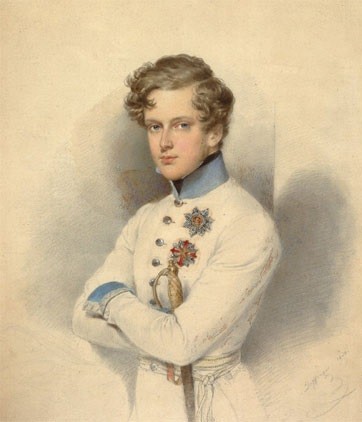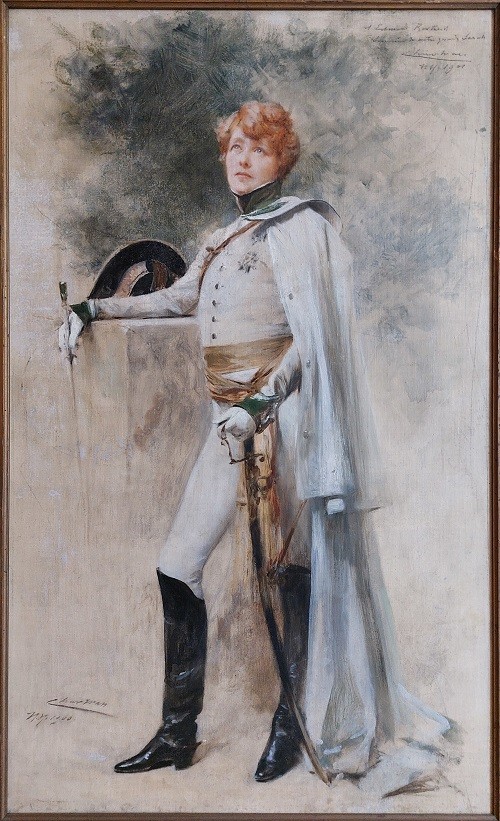The play written by playwright Edmond Rostand was first performed on 15 March 1900 at the Théâtre Sarah-Bernhardt (now the Théâtre de la Ville, Place du Châtelet, Paris). The title role was played by Sarah Bernhardt, dressed as a man for the occasion. The actress’s performance, praised by audiences and the press alike, was admired for the extreme sensitivity of her acting in the climactic moments of the drama. Everyone agreed that the role, the actress’s tragic performance and the character imagined by Edmond Rostand were a perfect match. L’Aiglon marked a new stage in the actress’s legend. Henceforth, the character would be assimilated to her.
► Listen to an extract of L’Aiglon with Sarah Bernhardt in the title role
This radiant oil painting by Théobald Chartran (1849-1907) immortalises the great actress in her role. It was donated to the Musée Edmond Rostand by Jean Rostand (Edmond Rostand’s youngest son) in 1962.
Théobald Chartran painted the ” monstre sacré ” [sacred monster], an expression coined by Jean Cocteau for Sarah Bernhardt, her red hair cut short, wearing a costume created by the great couturier Paul Poiret imitating the white uniform worn by the son of Napoleon I in one of the best-known portraits of the Duke of Reichstadt.

© Museum der Stadt Wien, Vienna
A long white cloak falling carelessly from the left shoulder, black knee-high boots and a wide gold belt completed the theatrical appearance of the man who was Napoleon II for only a few days in 1815. Sarah Bernhardt’s right arm rests on a pedestal on which her bicorne is placed. She is holding her baton in her hand. Her left hand rests on the hilt of her sword. This posture is reminiscent of the poses used by sovereigns for their official full-length portraits.
The highly realistic painting perfectly captures Sarah Bernhardt’s emotion and beauty. The model’s pose and expression are full of nobility and dignity. The painting reflects the strength and grace of the actress. In the top right-hand corner is a inscription by Théobald Chartran dated 11 November 1901: “À Edmond Rostand, Souvenir de notre grande Sarah” (To Edmond Rostand, in memory of our great Sarah). The painting is signed by the painter in the lower left-hand corner, dated 11 November 1900.
Although forgotten today, Théobald Chartran, painter of history, genre scenes and portraits nevertheless had his hour of glory. He was one of the leading exponents of academic painting at the end of the 19th century. He studied with Cabanel and began exhibiting at the Salon in 1872, winning the Grand Prix de Rome in 1877 with his historical painting, “Prise de Rome par les Gaulois” [Rome siezed by the Gauls], and a second medal at the Salon in 1881. Finally, he was awarded a silver medal at the 1889 Exposition Universelle. He had the gift of working quickly and rather well. His technique, although lacking in genius, was faultless.
This large canvas is an excellent example of Théobald Chartran’s art and of his work with light. The composition is very well balanced and the colours chosen are very delicate. The strength and grace of the scene are brought out by the choice of colours and the precision of the details. Théobald Chartran paid close attention to light and its effects in his compositions, as it was a way for him to give depth and movement to his paintings. He strove to capture natural light realistically and use it to give his paintings a richer, more vivid atmosphere. He used shadow and backlight to create dramatic effects and to emphasise the shapes and textures of the objects he painted. He also used gentle and more direct light to create brighter, more serene atmospheres. Light was an essential tool that he used to tell a story and bring his characters to life.
Through the antagonism between soft, diffused light and a dark, cloudy background, this painting perfectly captures Sarah Bernhardt’s flamboyant personality: nothing can obscure the light that shines within her and animates her.
Olivier Aubriet (translation RY)
March 2023
With a PhD of Pharmacy, a Master’s degree in Biological and Medical Sciences, HEC [Ecole des hautes études commerciales de Paris], and Sciences Po, Olivier Aubriet has worked for 25 years in the pharmaceutical industry in various capacities. He is a passionate collector of the works of Edmond Rostand, a major donor to the Musée Edmond Rostand [Edmond Rostand Museum] and the Fondation Napoléon, and a member of the Fondation Napoléon’s Circle of Ambassadors. He has been working for many years to promote a common cultural heritage that is accessible to all.
► This painting can be seen from 14 April to 27 August 2023 at the Petit-Palais as part of the exhibition Sarah Bernardt. Et la femme créa la star, organised by the museum to mark the 100th anniversary of the actress’s death on 26 March 1923.


